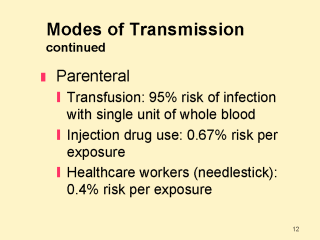 |
The second major way HIV is transmitted is through
parenteral exposure, where there is a break in skin integrity and direct exposure to
infected blood or blood products. HIV is very efficiently transmitted with transfusion of
infected blood; there is a 95% chance of infection when a single unit of whole blood that
is HIV-positive is transfused. Contaminated transmissions remain a significant problem in
areas where the blood supply is not routinely screened for HIV. Injection drug use carries
a risk of 0.67% per exposure and is responsible for the recent dramatic increases in HIV
infections in Eastern Europe. Healthcare workers have an approximately 0.4% risk of
contracting HIV per needlestick exposure from an infected patient. |
